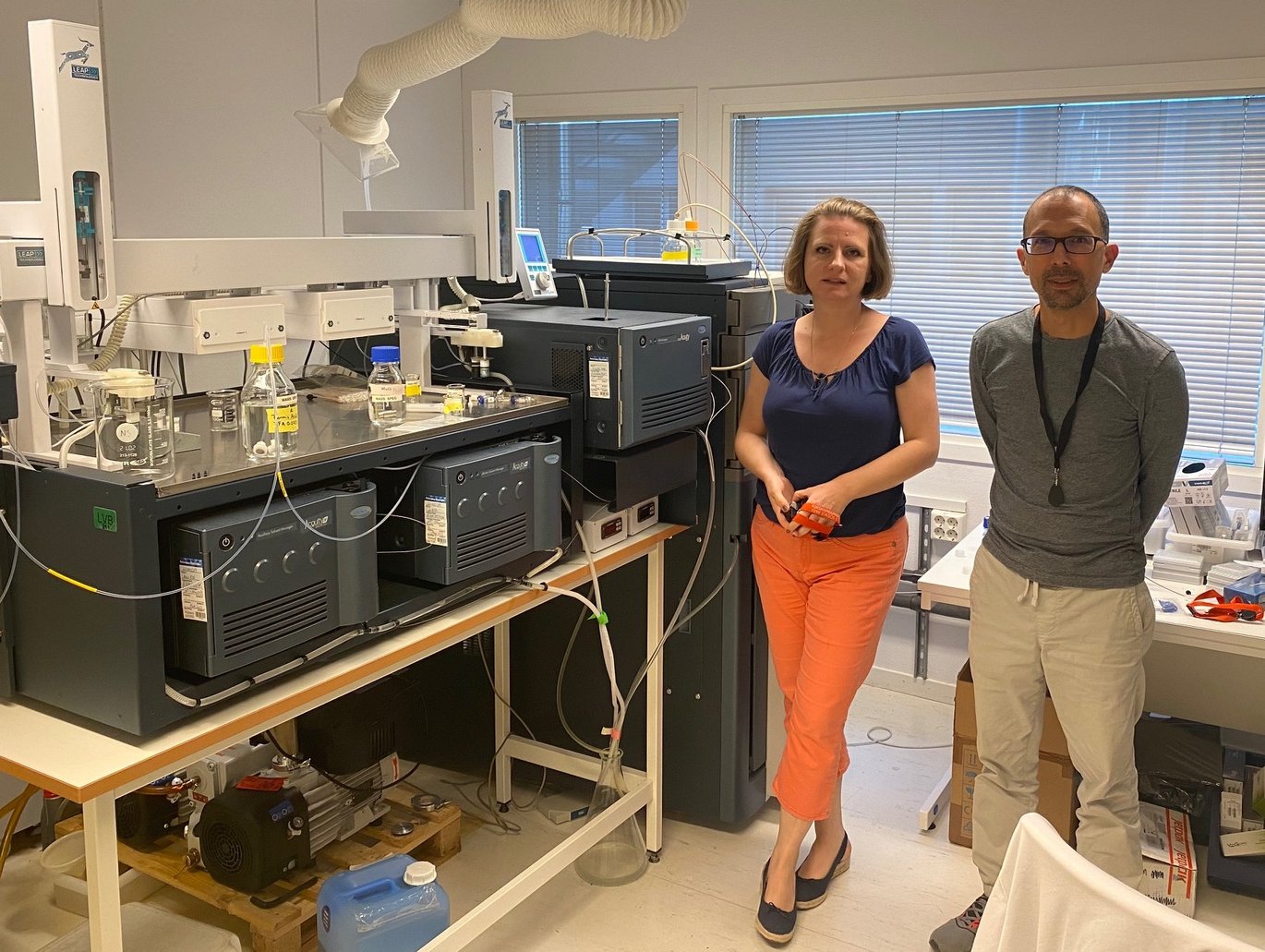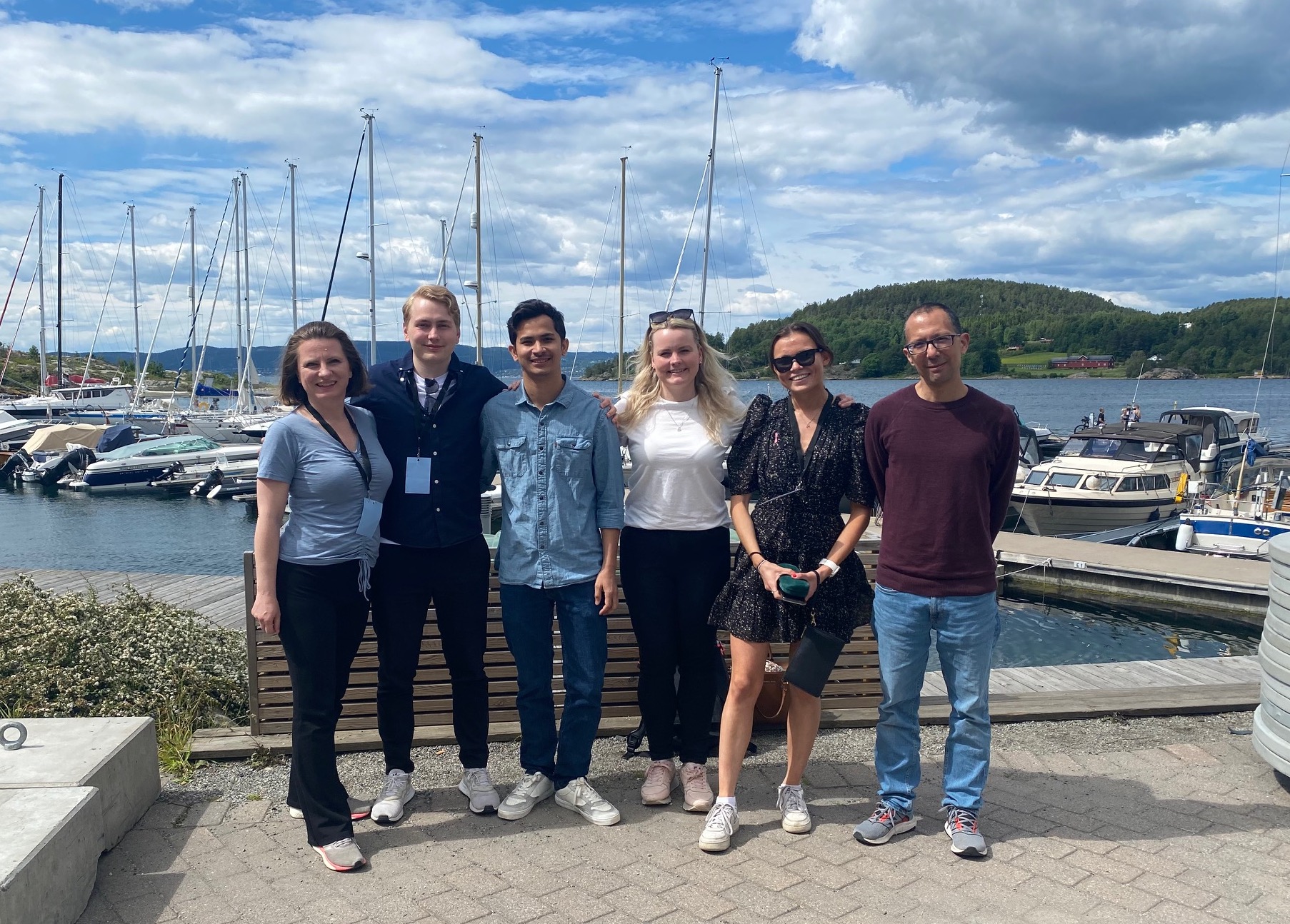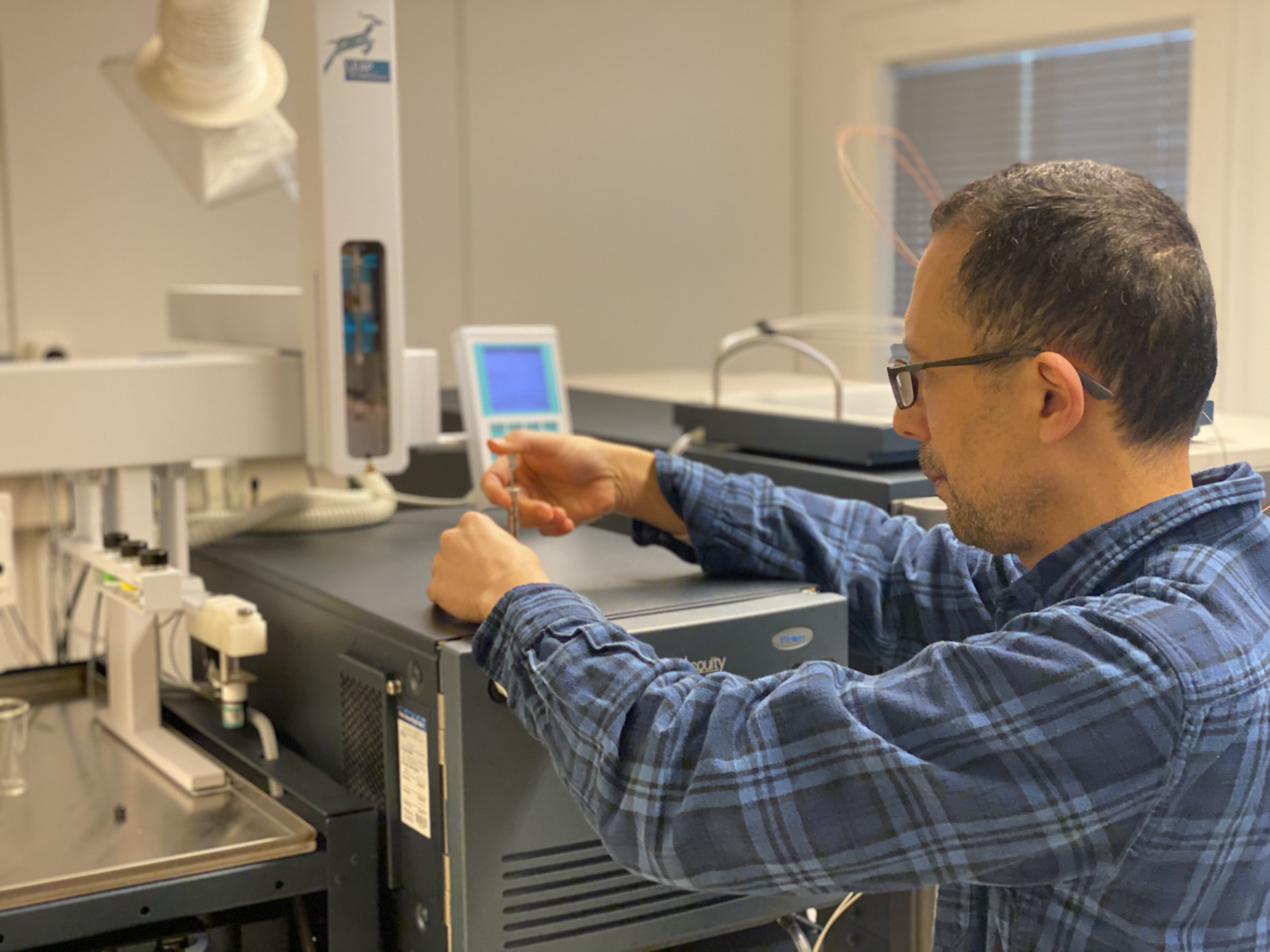Uncovering protein dynamics with hydrogen/deuterium exchange mass spectrometry in the Nordics
Meet NCMM Group Leader Nikolina Sekulić and Researcher Dario Segura Peña, and learn about the power of HDX-MS for mapping protein folding and determining conformational changes and protein interactions.



In 2019, Norway gained the capability to examine and understand protein structure dynamics like never before. Associate Professor Nikolina Sekulić and Dr. Dario Segura Peña set up Norway’s first and still only hydrogen/deuterium exchange mass spectrometry (HDX-MS) instrument at the Centre for Molecular Medicine Norway (NCMM) at the University of Oslo.
Coupled with their expertise, gained from working at the University of Pennsylvania (USA) with Profs. Ben Black and Walter Englander, the pioneer of HDX-MS, access to this technology in the Nordic research community means that researchers can answer questions about the contribution of protein dynamics to structure, stability, activity, and biomolecular interactions. Dr. Segura Peña explains:
Dynamics of proteins are important for their function. High resolution structures determined by X-ray crystallography will give us snapshots of proteins, but proteins move. Something that is more structured will be more rigid, while something less structured will move more.
And that can be determined with HDX-MS. He continues:
By studying protein dynamics, we can understand protein folding and unfolding. We can assess interactions between protein surfaces and ligands, drugs, or DNA. Where there is an interaction, the surface will be occluded and there will be less exchange of hydrogen for deuterium.
Dr. Sekulić emphasizes why this is important or interesting for researchers:
Sometimes even when we know the structure of a protein, we know very little about which parts of it are actually dynamic. The dynamic component is something that cannot be easily extracted from the structure itself, but is often related to its function.
She continues:
The real power in HDX-MS is actually comparing proteins in two different states. For example, bound to a drug and not bound to a drug or posttranslationally modified and non-modified. In this way, we get information about how the dynamics of the whole protein change when it binds the drug or is post-translationally modified. We can often see that the parts of the protein that are far away from the binding or modification site are affected, and this is something that structure alone cannot tell us.
Uses of the technique are numerous: studying protein binding to lipid, sugar, small chemical, or protein; conformational changes in proteins; protein folding and unfolding pathways; protein modifications, activity, stability and reproducibility, e.g., to optimize vaccine shipping and storage. These evoke interest from both academic and industry researchers.
How HDX-MS works
The technique is based on the fact that proteins contain hydrogen atoms both in peptide bonds and in their side chains. When the hydrogens are accessible, deuterium, a stable isotope of hydrogen, can replace hydrogen without changing protein structure. Deuterium is heavier than hydrogen, and this difference in atomic weight can be detected by mass spectrometry. Dr. Sekulić explains further:
When proteins are exposed to an aqueous solvent, peptide bond hydrogens exchange continuously with hydrogens from water. Hydrogens in hydrogen bonds, creating secondary structure of proteins, exchange slower. It's only the peptide bond hydrogens that are at the right time scale of exchange of seconds, minutes, and hours that we can measure in an experiment.
Dr. Segura Peña continues:
If we have a stable helix, the time window for seeing it fully exchanged can be on the order of hours, but if we have an unstructured helix or a loop, we will see very fast exchange, just seconds. To begin the exchange we simply put the protein into ‘heavy’ water (D2O). Then, we quench the exchange at different time points.
The exchange is then quantified by mass spectrometry, as Dr. Sekulić explains:
To read where the deuterium was incorporated, we chop the protein into peptides and separate and read the peptides by ultra high pressure chromatography and mass spectrometry. Since we know the sequence of the protein and the expected peptide masses we can see if the mass has increased or not. In this way we can identify parts of the protein that are more dynamic than others. In the next step, we investigate how this pattern changes when protein states change.
Thus, hydrogen/deuterium exchange is the process and mass spec is the readout.
A community of science for understanding protein structure-function relationships
The HDX-MS instrumentation is housed at NCMM as part of the PX-Oslo Structural Biology core facilities at the University of Oslo, which offers services to local, national and international researchers. But PX-Oslo is more than a facility or collection of equipment. It’s a community of expertise in protein production, X-ray crystallography, protein structure dynamics, and biophysical characterization of proteins.
The community shares ideas and gleans essential information about protein structure and function. By combining information from various techniques, they gain the most thorough understanding of protein structure and function.
The facility comprises five research groups at the University of Oslo (Krengel, Sekulić, Dalhus, Hersleth and Lund) and makes available their expertise and state-of-the-art instrumentation for a wide array of protein structure-related technologies in-house - including large-scale protein expression and purification, protein crystal screening and imaging, X-ray data collection and processing of diffraction data and modeling, microscale thermophoresis, isothermal titration calorimetry, surface plasmon resonance, nano-differential scanning fluorimetry, dynamic light scattering, and SEC-MALS - all in addition to HDX-MS for mapping protein folding, conformational changes, protein-ligand and protein-protein interactions.
Through a collaboration with the Department of Chemistry, users can also collect small-angle X-ray scattering data. Regular access to leading international synchrotron radiation facilities such as ESRF in Grenoble, France; MAX IV in Lund, Sweden, and DESY in Hamburg, Germany can be facilitated. Neutron data collection can be arranged with world-leading facilities such as the Institut Laue-Langevin in Grenoble, and the ISIS Neutron and Muon Source in the UK.
Dr. Sekulić describes the Nordic HDX community, in particular:
The HDX community is small, but growing together with advances in instrumentation and software that are expanding and evolving the capabilities. We are currently the only ones in Norway, and in the whole the Nordic EMBL Partnership. There is a facility in Lund, Sweden. And there are two facilities, at least, in Denmark, one at the University of Southern Denmark and one at the University of Copenhagen, where there is a strong tradition of HDX-MS.
And, on the international scene:
We are well-incorporated into the International Society of HDX-MS that organizes conferences and seminars for knowledge sharing. Dario has recently returned from the 3rd international HDX-MS conference in London where he was invited to talk about our research.
The power of hydrogen/deuterium exchange is already getting some traction with academic researchers outside of the University of Oslo with molecular medicine collaborations at the Oslo University Hospital and the University of Bergen. And, interest from regional biotech companies is on the rise.
From scientific interests to technology
For Dr. Segura Peña, it was changes in phosphorylation of the Aurora B protein which regulates centromeres and cell division that piqued fascination with HDX-MS:
Even though there was a crystal structure, nobody could figure out how phosphorylation modulated activity. Then I ran into HDX because I was at Penn, and I started using the technique. It worked beautifully, because there were a lot of dynamic changes. And then I stuck with the technique because it has so many applications.
Dr. Sekulić’s interest in the technology also grew out of her scientific interests as well as a thirst for knowledge:
As a young student, I always wanted to understand how things worked. And when I finished my studies I was hungry for more. I went to the US (from Belgrade, Serbia) for a PhD degree, and there I experienced a different science environment. It’s one thing to read about things in textbooks, but only when you're doing experiments yourself do you see what science really is - that everything is based on experiments and how they are interpreted. It was inspiring!
She continues:
I was learning X-ray crystallography during my PhD, and I liked it a lot because I like visual things. It was really fascinating to see structures of proteins in three dimensions. The next layer was learning how to interpret the structures. And then what I really wanted was to move into something even more complex.
And, Dr. Sekulić found that complexity in cell division during her postdoc, “they had research questions that they were chasing. A protein structure was just one little part. The interdisciplinarity challenged me beyond a narrow expertise, and I could see a bigger picture and use other tools to drive to the answer.”
For Drs. Segura Peña and Sekulić, further inspiration and motivation come from their team members. Dr. Sekulić explains, “it’s nice to see people growing and moving on with a certain knowledge. In the beginning, we have to guide them a lot. And then after some time, they start giving us ideas. I think that's really inspiring.”
The Sekulić research group at NCMM is using HDX-MS to uncover clues to their scientific questions. Dr. Sekulić gives an example:
Aurora B, a protein kinase important for chromosome segregation in mitosis, is a target of anticancer drugs. The enzyme exists in active (phosphorylated) and inactive (non-phosphorylated) forms, but because of the flexible parts of the enzyme, it has been difficult to study the activation process using classical structural biology techniques such as X-ray crystallography. We used HDX-MS and found that phosphorylation clearly structures the enzyme. Furthermore, we identified the exact parts of the enzyme that undergo changes and we analyzed how these changes correlate with the different phosphorylation sites and with the overall activity of the enzyme.
While their research is addressing fundamental questions, there are also clear implications for improving medical applications in the future. Dr. Sekulić explains:
We're trying to understand fundamentals of chromosome segregation that can have huge implications for biomedical engineering, for example engineering and stability of artificial chromosomes. I have no doubt that what we're doing now is going to benefit society. The more thorough the basic knowledge, the more likely that treatments derived from the research are going to be successful. The more we understand, the more we have control of the system, and the better the translational science we produce for society.
Dr. Segura Peña puts their basic research into an even higher context, “the purpose of basic science is to create knowledge; knowledge is what has driven us as human beings. As a species, we're always asking why.”
Now it’s your turn to ask why and uncover protein dynamics!
HDX-MS for your research project
The hydrogen/deuterium exchange mass spectrometry (HDX-MS) instrument at the University of Oslo is housed at NCMM and offered as part of the PX-Oslo – UiO Structural Biology Core Facilities for mapping protein folding, conformational changes, and protein interactions. The core facility also offers services in protein expression and purification, X-ray crystallography, and biophysical characterization of proteins.
Drs. Nikolina Sekulić and Dario Segura Peña provide their expertise for consultation and manage the instrument. Researchers interested in exploring the possibilities of HDX-MS for their research can contact Drs. Sekulić and Segura Peña directly by email.
Dr. Sekulić explains the process, “when researchers are interested, we always start off with a consultation and discussion to understand what they want to address, and if HDX-MS can give them what they want.” Every experiment is then optimized prior to data collection and analysis. “The fees we collect help us to cover the cost of the instrument service contract and the time we spend running samples and collecting data,” says Dr. Segura Peña.
Mobility funding from a NordForsk Infrastructure Hub grant may help cover costs for visits to the facility for researchers affiliated with Nordic EMBL Partnership institutes. Please contact your local administration for more information.
The “Technologies Advancing Molecular Medicine” series highlights the people and activities in research technologies and core facilities in the Nordic EMBL Partnership for Molecular Medicine.